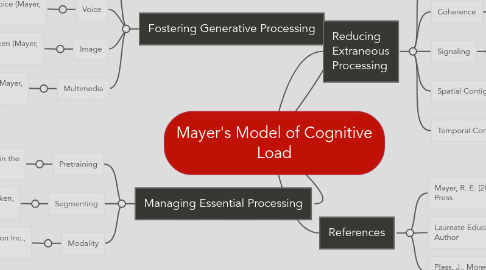
1. Managing Essential Processing
1.1. Pretraining
1.1.1. people learn better when they are familiar with the concepts in the lesson (Laureate Education, 2009)
1.2. Segmenting
1.2.1. break the explanation up into bite sized chunks to the the presentation is still under the learners control (Plass, Moreno, & Brunken, 2010)
1.3. Modality
1.3.1. when words are presented in spoken form rather than printed form (Laureate Education Inc., 2009)
2. Fostering Generative Processing
2.1. Personalization
2.1.1. words are presented in conversational (speaking) style (Mayer, 2009)
2.2. Voice
2.2.1. people learn more deeply when the words in a multimedia message are spoken by a friendly human voice than by a machine voice (Mayer, 2009)
2.3. Image
2.3.1. People do not necessarily learn better from a multimedia lesson when the speaker's imageis added to the screen (Mayer, 2009)
2.4. Multimedia
2.4.1. people learn more deeply from words and pictures than from words alone (Mayer, 2009)
3. Reducing Extraneous Processing
3.1. Redundancy
3.1.1. does not include on-screen text (words) to graphics/pictures (Mayer, 2009)
3.2. Coherence
3.2.1. keeps things simple by reduncing unnecesary words and pictures (Mayer, 2009)
3.3. Signaling
3.3.1. highlights or bolds important words and pictures (Mayer, 2009)
3.4. Spatial Contiguity
3.4.1. places printed text near the corresponding pictures (Mayer, 2009)
3.5. Temporal Contiguity
3.5.1. presents related words and graphics at the same time (Mayer, 2009)
